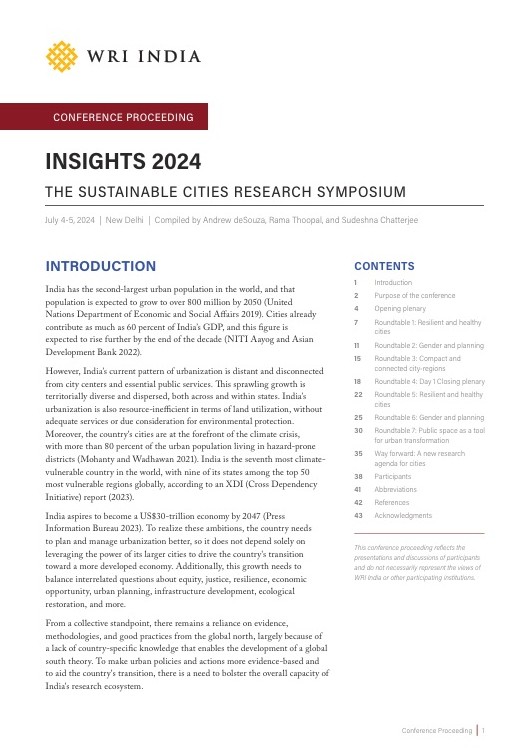Sustainable Development the Only Way to End Air Pollution Menace
by -
This blog post first appeared in Hindustan Times.
Air pollution is a health emergency. Schools are shut, many offices have offered work from home to their employees. The air outside is so bad that doctors are asking people to leave Delhi NCR, if possible. In this forced vacation, my 10 year old daughter asks me if I also had pollution break during my school days?
The question has been puzzling me. It was last year when we experienced ‘pollution break’ for the first time. This year for last four days we are locked inside our rooms, door and windows shut and air purifier on full speed. Is this the sign of things to come? I mean annual ‘pollution breaks’!
How did life in a metro became life in a gas chamber? I think we underestimated the air pollution issue and that’s why we are in a mess right now. Let me explain a little.
What’s poisoning the air?
There are two sources of air pollution – continuous and episodic. Continues sources are those that emit all-round the year like transport, power plants etc. Episodic sources are those that emit a certain time of the year like crop burning, Diwali etc. The Indian Institute of Tropical Metrology (IITM), Pune which falls under the aegis of Ministry of Earth Sciences (MoES) did a high resolution emission inventory for Delhi. Transport sector was responsible for 40% of pm 2.5 emission for Delhi. Wind-blown sources like dust, fly ash, soot etc were responsible for 21% in Delhi. Emission from industry was at 19% in Delhi. Episodic events further added to the already polluted air in Delhi. For example, a study by TERI found that agricultural burning or stubble burning as it is known was responsible for 40% of pm 2.5 emission during peak period. Adverse metrological condition added to the cause. Therefore, Delhi already has bad air which becomes poisonous during winter period due to stubble burring and fire crackers during Diwali.
Why pollution is on the rise?
The inability to understand the impact of our action on air pollution is the prime reason why air pollution is on the rise. Let’s take the case of transport sector. The IITM study suggested that the pm 2.5 emission from transport sector in Delhi were around 25% in 2010 which is now at 40%. So what’s contributed to this increase? The sheer increase in the number of vehicles. Simple. In 2010 Delhi had around 2.5 million registered motor vehicles. The number is now over 10 million. More roads, more flyovers, free parking coupled with the decline in the share of public transport is responsible for the growth in personal vehicles. So more vehicles means more emission. Similarly, the rise in stubble burning is also a due to the same reason. It takes about 120 days for rice from germination to harvest. The restriction on sowing of grains for supposedly prevention of ground water depletion means that harvest will happen in October. Therefore, farmers get very little time to clear the field and prepare for the next crop and the easiest and cheapest way out is the crop residue. This coincides with the Diwali and an unfavourable weather condition resulting in severe pollution in Delhi NCR.
How can the air be cleaned?
The battle to tackle air pollution battle is tough but winnable provided we work all round the year. For example, measures alike odd even or ban on construction activity etc that are needed during the three month emergency period but the real change will depend on what we do during the rest of the nine month period. Let’s take the case of transport sector, Delhi, Gurugram and many other cities are trying to solve traffic problems by building more roads. Now, it’s not rocket science to understand that more roads means more vehicles and therefore more pollution. Therefore, it is important for cities to focus on restricting use of private motor vehicles and encourage more walking, cycling and public transport. This will require all round action and not just 15 days of odd- even. Similarly, local issues like ban on waste burning, clearing of road dust etc also need to be dealt all-round the year. Episodic events like stubble and fire cracker burning has to end completely. Just putting a ban on stubble burning will not work as livelihood of farmers are at stake. There has to be an economic model around reuse of the agricultural waste.
The symptom is air pollution but the problem is sustainability. For example, reducing transport emission in about sustainable transport. Similarly emission from power plant is all about sustainable energy and episodic events like stubble burring is all about sustainable agriculture.
Therefore, addressing air pollution is linked to sustainable development. This why the national government has to step in if we really want blue skies in our cities. The central government has to take leadership role and work with states proactively only them the problem will be addressed. Else, we will be having the same discussion in 2020.


